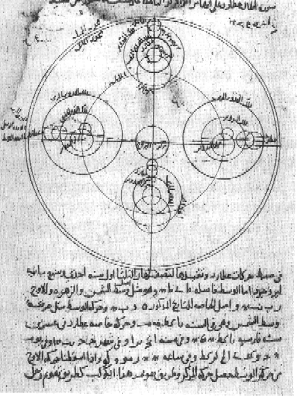
Ibn al-Shatir's model for the appearances of Mercury, showing the multiplication of epicycles in a Ptolemaic enterprise. From T.E. Huff, The Rise of Early Modern Science: Islam, China, and the West (Cambridge, 1993).
Home -> Ptolemaic System ->Notable Features
Ptolemy's work represented the pinnacle of Hellenistic astronomy, and of mathematical science in general in the classical period. After the decline of Roman power, however, technical astronomy of this caliber fell into abeyance in western Europe.
But it continued to be practised in Islam. Beginning in the seventh century, Muslim scholars learned Greek knowledge encountered from Byzantium and other points of contact, and some sought to pursue astronomical work according to principles found in Ptolemaic sources. Instruments were built to Ptolemaic prescriptions, and observatories founded in which they could be put to use. By the ninth century there was a major one in Baghdad. The most monumental was at Samarkand, where Ulugh Beg (1394-1449) had gigantic instruments built out of stone. The most successful, however, was that at Marâgha, in what is now western Iran, which facilitated the production of accurate observations by using particularly finely-wrought - and particularly huge - instruments. For generations, astronomers at Marâgha sought to perfect Ptolemy's systems and reconcile them with Aristotelian philosophy. By the late fourteenth century they had produced mathematical models in a broadly Ptolemaic idiom that were mathematically equivalent to those used by Copernicus in the West almost two centuries later.
Knowledge of Ptolemaic practices was reconstructed in Western Europe in the years after the mid-twelfth century. Contact between Christians and Muslims in Spain, and especially at Toledo, encouraged a demand for translations of Arabic works containing Greek philosophy - or for the Greek originals where they could be had. The Syntaxis was translated by Gerard of Cremona. By a transliteration of its Arabic title, it became the Latin Almagest. In these translations, Ptolemy was often confused with the Egyptian pharoahs of the same name. Gradually Ptolemaic practices and priorities came to characterise Western astronomy, assisted by the invention of the printing press in the mid-fifteenth century and its early use by Regiomontanus to recover and publish classical sources.
Site Map | Contact Us